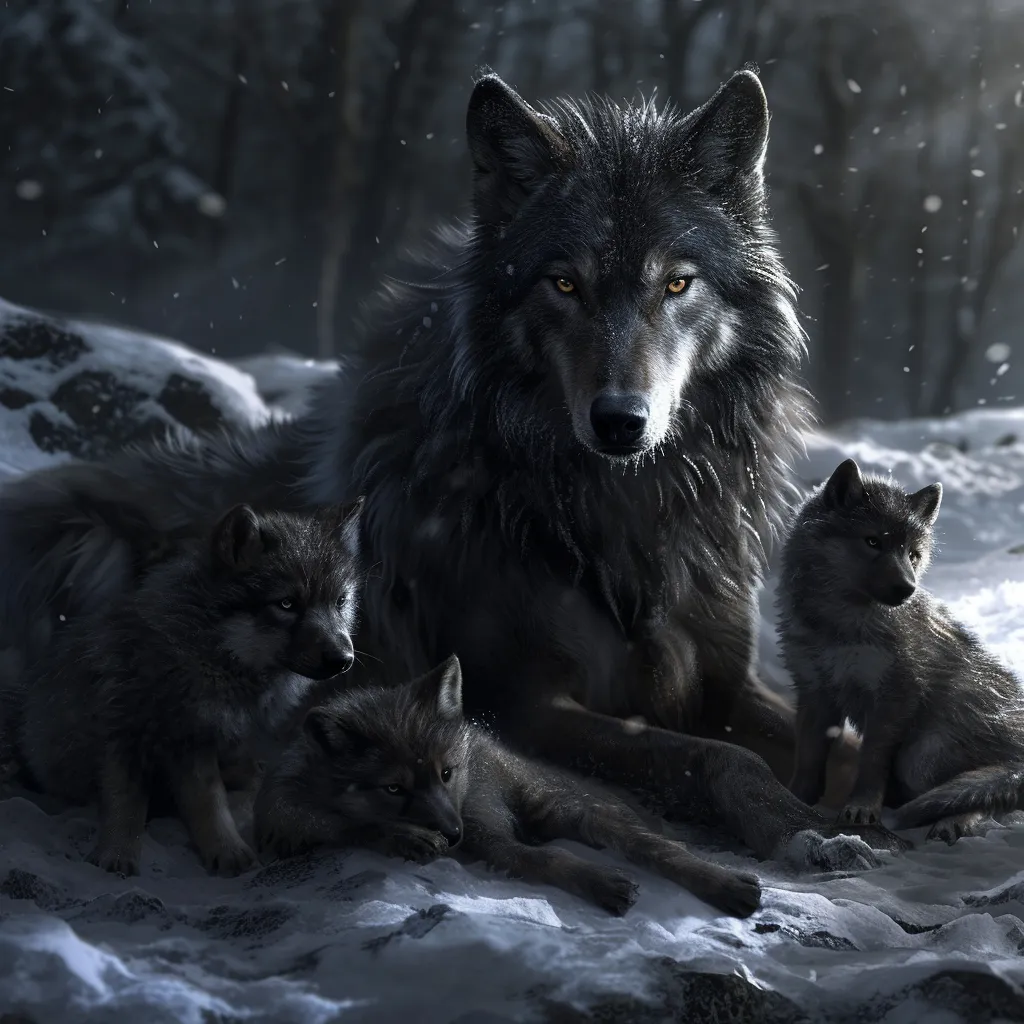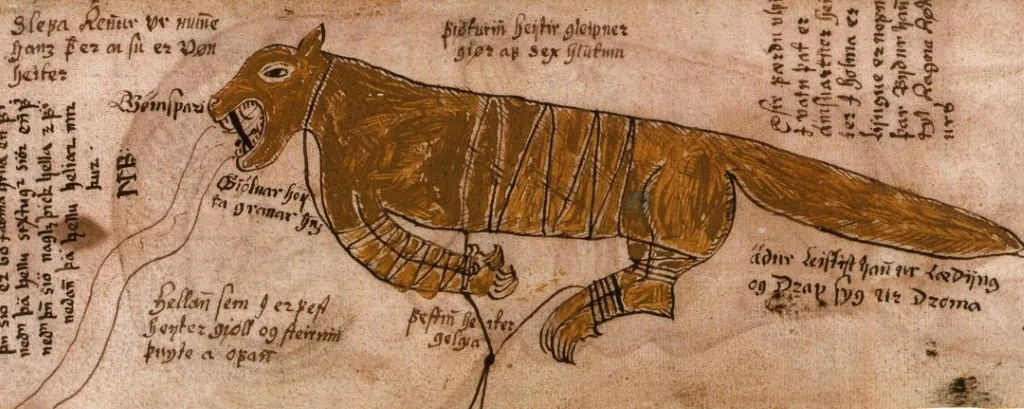Fenrir (FEN-rear)
Dire Wolf
The earth feels different when Fenrir is near. Not heavier—more deliberate. Stones embedded in hillsides seem to hum underfoot, and wind across the grassline takes on a rhythm it did not have before. He does not approach so much as align, emerging from behind promontories as if he had always been there, the land reshaping itself around his silhouette. He stands, then walks, not to follow or lead, but to occupy the exact midpoint between stillness and shift.
He appears most often along the broken lines where past movement faltered—old roadbeds overtaken by lichen, cliff edges where stone fractured but never fell. Even his gaze feels geological, slow and without urgency, as if tracking a thought the mountains once had but never finished. Where he passes, moss climbs more surely up bark and the curve of dry streambeds begins to round.
His steps do not imprint the soil. Instead, they resonate just beneath it, as if the body itself were not weight but force shaped into form. Birds never scatter at his passing, nor does foliage recoil. The Realm does not resist him; it adjusts. He moves in single lines of travel, often repeating a path days apart with no alteration in stride or angle, as though marking something only the land can read.
Even when resting, Fenrir appears engaged with distance. He lies on outcrops that overlook not places, but intersections—where leyline shadows tangle or where the sky presses lower to meet stone. His body curls neither defensively nor for warmth, but as a closed loop of presence, holding a tension that never tips into action. The Realm seems to breathe differently in his stillness.
Some say that to cross his gaze is to remember something you’ve never done. He doesn’t provoke this memory, nor hold you in it. He simply bears it with you. Then he moves on, vanishing without dispersing, leaving a faint vibration that lingers in stone longer than sound or scent ever could.
In Norse mythology, Fenrir is the bound wolf fated to break free at Ragnarök. The Tír na nÓg being bears no destructive purpose but retains the myth’s gravity and inevitability. His repetition of fixed paths and silence reflect the echo of prophecy without its mortal consequences. Iceland – Eddic Poetry
Poetic cycles often frame Fenrir as a force of future tension, not evil but uncontainable. The Realm’s Fenrir reflects this role not through conflict, but through pressure. He does not act but exists—his presence marking thresholds yet to open. Sápmi – Noaidi Tales
Among the Sámi, stories of land-walkers—silent beings who press the world into shape with their steps—resonate strongly. While Fenrir is not claimed by these tales, his manner and pattern evoke similar reverence: a being whose motion writes across terrain rather than traverses it.
Behavior & Communication
Fenrir exhibits consistent pacing behavior across elevated stone corridors and isolated grassplateaus. He follows cyclical walking patterns with high spatial precision, often repeating a specific ridgeline traversal with unaltered tempo and distance regardless of ambient interruption. These patterns can extend for days without pause. Communication appears to occur through subtle head angling and full-body orientation. No known vocalizations or auditory signals have been recorded. Instead, field researchers note sudden alignment shifts—Fenrir adjusting posture in coordination with geomantic fluctuations or the presence of memory-dense fauna. This behavior resembles harmonic tracking rather than response or display. When confronted with new stimuli, Fenrir does not alter course but modulates pace by fractional increments, maintaining course fidelity. His gaze fixes for extended periods on static terrain features, especially ancient cairns or megalithic fragments. These watch states have been observed to last through full sunrise intervals without movement. Fenrir’s presence alters resonance levels in nearby terrain. Soil density shifts minimally, and root patterns beneath his traversed paths reorient slightly. This may serve as indirect communication across plant or fungal networks. No signs of aggression, challenge, or avoidance have been observed among other fauna.Ecological Niche
Fenrir is endemic to highland stonebrush terrain and temperate torscapes, preferring sites with exposed bedrock, intermittent heather cover, and high aetheric compression. These areas are generally low in audible fauna traffic but dense with residual geomantic memory and slow-shifting leyline currents. His activity does not modify terrain physically, but resonance patterns indicate a consistent signature left along traversed paths. These paths often become reference lines for migratory drift patterns in mistveil flora and localized energy rhythm in nearby plant clusters. Moss thickness and quartz crystal orientation tend to stabilize along Fenrir’s frequented lines. Though not territorial, Fenrir’s habitual routes are long-maintained and can be recognized across multiple moon cycles. These routes often align with long-forgotten mortal pathways—those once used and then abandoned, now absorbed by the Realm and re-mapped through his motion.Common Myths & Legends
Scandinavia – Norse TraditionIn Norse mythology, Fenrir is the bound wolf fated to break free at Ragnarök. The Tír na nÓg being bears no destructive purpose but retains the myth’s gravity and inevitability. His repetition of fixed paths and silence reflect the echo of prophecy without its mortal consequences. Iceland – Eddic Poetry
Poetic cycles often frame Fenrir as a force of future tension, not evil but uncontainable. The Realm’s Fenrir reflects this role not through conflict, but through pressure. He does not act but exists—his presence marking thresholds yet to open. Sápmi – Noaidi Tales
Among the Sámi, stories of land-walkers—silent beings who press the world into shape with their steps—resonate strongly. While Fenrir is not claimed by these tales, his manner and pattern evoke similar reverence: a being whose motion writes across terrain rather than traverses it.
| APPEARANCE/PHENOTYPE |
|---|
| Canid-bodied and stone-toned, Fenrir bears a massive, broad-shouldered frame with short dense fur of mottled greys, greens, and dark russet. His limbs are long and muscled, but without bulk. The paws are broad and stone-splayed, suited for terrain contact rather than speed. Eyes are deep-set and appear matte rather than reflective. The head is wide at the jaw but without flare. His posture holds tension between readiness and repose, often standing for hours in a single position without evident discomfort. Fur along the spine shows faint striation, echoing glacial scoring patterns. |
height |
length |
weight |
|---|---|---|
1.1 m |
2.4 m (including tail) |
61 kg |
Genetic Ancestor(s)
Scientific Name
Ainmhí; Réamhach; Lophostone fenrir
Origin/Ancestry
Once a symbol of destruction in myth, now a respected member of the island's fauna.
Ancient Fenrir
A 17th-century manuscript illustration of the bound Fenrir, the river Ván flowing from his jaws. From AM 738 4to, Edda oblongata or Langa Edda.


















